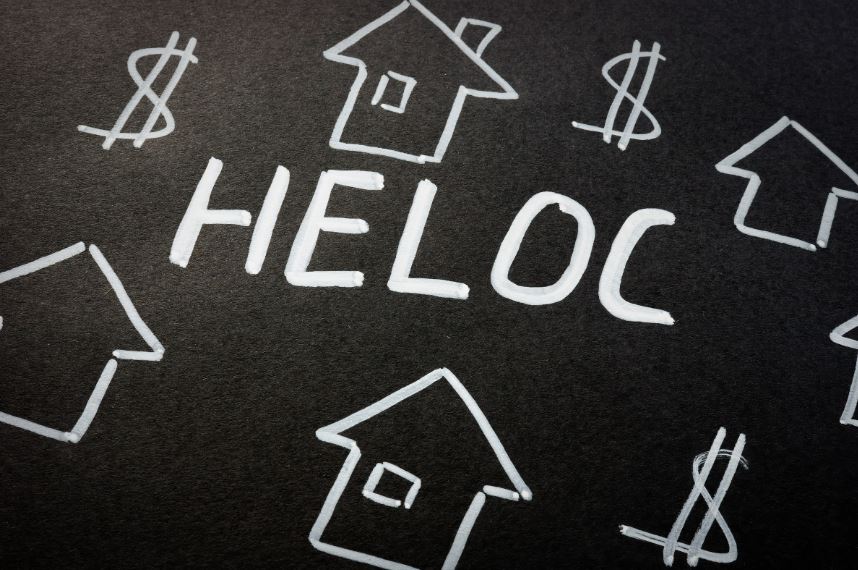In the ever-evolving landscape of homeownership, navigating the vast array of financial options can be both exciting and overwhelming. Among the plethora of choices available, the Home Equity Line of Credit (HELOC) stands out as a versatile and accessible financial product that empowers homeowners to leverage their property’s equity.
Table of Contents
By tapping into the equity they have built up over time, homeowners can access a pool of funds that can be used to finance various needs, from home improvements to debt consolidation and beyond.
In this comprehensive guide, we will delve deep into the intricacies of HELOCs, exploring their definition, advantages, drawbacks, and best practices for responsible management.
What is a Home Equity Line of Credit?
At its core, a Home Equity Line of Credit, commonly known as HELOC, is a form of revolving credit that grants homeowners access to a pool of funds based on the equity they hold in their property. To grasp the concept fully, it’s essential to break down the key components that make up a HELOC.
Equity: At the heart of a HELOC lies the concept of equity, which represents the current market value of the property minus any outstanding mortgage balance. For instance, if your home is valued at $300,000, and you owe $150,000 on your mortgage, your equity stands at $150,000.
Revolving Credit: Unlike conventional loans with fixed terms and regular monthly payments, a HELOC operates similarly to a credit card. It offers a pre-approved credit limit, and homeowners can draw funds as needed during the draw period, which typically spans ten years. After the draw period, a repayment period ensues, during which borrowers must repay any outstanding balance.
The Key Differences Between HELOC and Home Equity Loans
While HELOCs and home equity loans both enable homeowners to leverage their home equity, they are fundamentally different financial products, each with its own set of advantages and drawbacks. Understanding these distinctions is essential in making an informed decision based on individual circumstances and financial goals.
HELOC
As mentioned earlier, a HELOC functions like a revolving line of credit, providing unparalleled flexibility in borrowing and repaying. During the draw period, homeowners can make multiple withdrawals and repayments, making it an ideal option for ongoing projects or expenses with varying costs over time.
This versatility sets it apart from home equity loans, which disburse a fixed sum upfront, with fixed interest rates and monthly payments.
Home Equity Loan
In contrast, a home equity loan offers a lump-sum disbursement of the entire loan amount upfront. Borrowers receive a fixed interest rate and are required to make consistent monthly payments over the loan term.
This structure is suitable for one-time expenses, such as a home renovation or debt consolidation. Each option has its merits, and selecting the right one hinges on a thorough assessment of individual financial needs and preferences.
Finding The Right Lender
When it comes to selecting a trusted lender, homeowners should prioritize their financial security and safety. An exhaustive comparison of multiple HELOC lenders is necessary to ensure that borrowers are getting the best possible terms in terms of rate, fees, and repayment flexibility. It’s also important to check for a lender’s legitimacy by verifying its online presence and physical address. Additionally, familiarizing oneself with the regulatory framework governing home equity lines of credit in their state is highly recommended.
These steps are especially critical for borrowers who opt to refinance an existing HELOC with a new lender, as they will need to navigate the complexities associated with such transactions. It’s worth noting that some lenders offer competitive offers and packages for refinancing, so exploring these options is essential.
Overall, finding the right lender requires due diligence and research to ensure that borrowers are making an informed decision and have the best possible terms in place for their financial goals. Ultimately, taking the time to properly weigh all available options can pay off dividends in the long run.
Advantages of a HELOC
- Flexibility: The hallmark advantage of a HELOC lies in its unmatched flexibility. Homeowners have the freedom to draw from the line of credit as needed and in varying amounts, unlike a home equity loan that disperses a fixed sum upfront. This makes a HELOC an ideal choice for funding ongoing projects or expenses with unpredictable costs over time.
- Lower Interest Rates: In general, HELOCs come with lower interest rates compared to credit cards and certain other forms of consumer credit. This makes a HELOC a cost-effective option for borrowers seeking to fund significant expenses without incurring exorbitant interest charges. Lower interest rates can lead to substantial savings over the life of the loan.
- Tax Deductibility: Another enticing aspect of a HELOC is the potential tax deductibility of the interest paid on the loan. Under certain conditions, homeowners may be able to deduct the interest on their HELOC from their federal income taxes, effectively reducing the cost of borrowing. However, it is crucial to consult with a tax advisor to understand the specific tax implications based on individual circumstances.
- Diverse Uses: The versatility of a HELOC extends to its diverse range of uses. Borrowers can utilize the funds for various purposes, such as home renovations to enhance property value, educational expenses to invest in personal growth, medical bills to ensure well-being, debt consolidation to manage finances efficiently, or even as a financial safety net during emergencies. The ability to access funds for a wide array of needs makes a HELOC a valuable financial tool.
Drawbacks of a HELOC
While HELOCs offer numerous benefits, it is essential to consider potential drawbacks before committing to this financial product.
- Variable Interest Rates: Unlike home equity loans that often feature fixed interest rates, HELOCs typically come with variable interest rates. These rates are subject to change based on market conditions, potentially causing fluctuations in borrowers’ monthly payments. This element of uncertainty requires careful financial planning and consideration of potential interest rate changes over time.
- Potential Over-Borrowing: The flexibility of a HELOC can be a double-edged sword. Homeowners may be tempted to borrow more than necessary, leading to excessive debt and financial strain in the long run. Responsible borrowing and careful financial planning are crucial to avoid this pitfall. Assessing actual needs and borrowing only what is essential will prevent overextending financial resources.
- Risk of Foreclosure: A critical aspect of Home Equity Lines of Credit is that the borrower’s property serves as collateral for the loan. Failure to meet repayment obligations can put the home at risk of foreclosure, making it imperative for borrowers to manage their HELOC responsibly. Adhering to a well-thought-out repayment plan is essential to safeguard homeownership.
- Changing Financial Landscape: Economic shifts and fluctuations in property values can impact the terms and conditions of a HELOC. Borrowers must be prepared for potential adjustments in their credit limits and interest rates over time. Staying informed about economic trends and proactively adapting to changes can help homeowners navigate uncertainties successfully.
Responsibly Managing Home Equity Lines of Credit
To maximize the benefits of a HELOC while minimizing potential risks, homeowners should adopt the following best practices:
- Establish a Repayment Plan: Before tapping into a HELOC, create a clear and comprehensive repayment strategy. Assess your financial situation, set a budget, and determine how much you can afford to borrow and repay each month. A well-structured repayment plan ensures that borrowing remains within manageable limits and prevents the accumulation of unnecessary debt.
- Monitor Interest Rates: Vigilantly monitor interest rate trends and be prepared for possible fluctuations. While variable interest rates offer the potential for lower rates initially, they can rise over time, impacting monthly payments. If you’re concerned about rising rates, consider refinancing your HELOC or converting it to a home equity loan with a fixed interest rate.
- Avoid Splurging: While the flexibility of Home Equity Lines of Credit may be enticing, it’s essential to borrow only for necessary expenses and financial goals. Avoid using the line of credit for discretionary spending which may lead to financial strain down the road. Developing a disciplined approach to spending ensures that funds are used judiciously and responsibly.
- Regularly Review Finances: Periodically review your financial situation and assess whether your borrowing and spending align with your long-term goals. Life circumstances, financial priorities, and goals may change over time, requiring adjustments to your approach. A proactive and adaptive mindset allows homeowners to stay on track and make informed decisions.
In conclusion, Home Equity Lines of Credit can be a valuable financial tool for homeowners seeking flexible and accessible funding. Understanding the nuances of a HELOC, including its advantages, drawbacks, and best practices for responsible management, is crucial for making informed decisions.
Whether you’re planning a home improvement project, consolidating debts, or addressing unexpected expenses, financing your business, a HELOC can serve as a powerful ally in achieving your financial goals.
Remember, thorough research, careful consideration of your financial needs, and consultation with a qualified financial advisor are essential steps before committing to any significant financial undertaking.
By approaching Home Equity Lines of Credit with prudence and responsibility, you can harness the potential of your home equity while protecting your financial well-being and ensuring a more secure future.
The journey to financial empowerment begins with education and strategic planning, and a HELOC can be a valuable tool to unlock opportunities for growth and stability on your homeownership journey.
Frequently Asked Questions (FAQ) About Home Equity Lines of Credit
What is the difference between Home Equity Lines of Credit (HELOC) and Home Equity Loans?
A HELOC operates like a revolving line of credit, allowing homeowners to borrow against their home equity as needed during the draw period and make multiple withdrawals and repayments. On the other hand, a home equity loan disburses a lump sum upfront, with fixed interest rates and regular monthly payments over the loan term.
How can I use the funds from a HELOC?
HELOC funds can be used for various purposes, such as home renovations, educational expenses, debt consolidation, medical bills, or even as a financial safety net for emergencies. The flexibility of a HELOC allows borrowers to address a wide range of financial needs.
What are the risks associated with Home Equity Lines of Credit?
While a HELOC offers advantages like lower interest rates and tax deductibility, it also comes with risks. Variable interest rates can lead to fluctuations in monthly payments, and over-borrowing could result in excessive debt. Additionally, failure to meet repayment obligations may put your home at risk of foreclosure.
Is the interest on Home Equity Lines of Credit tax-deductible?
In many cases, the interest paid on a HELOC may be tax-deductible, provided it is used for qualified home-related expenses. However, tax laws can change, and individual circumstances vary, so it is essential to consult with a tax advisor to understand the specific implications of your situation.
How can I find a qualified financial advisor?
When seeking professional advice, look for an accredited and experienced financial advisor who can provide personalized recommendations tailored to your specific goals.
Research advisors in your area, check references, ask questions, and compare services and fees before making a decision. Additionally, the National Association of Personal Financial Advisors (NAPFA) offers a comprehensive financial advisor directory to facilitate your search.



